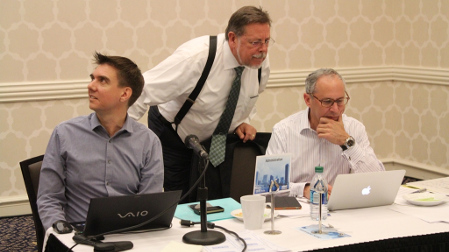Sinclair/ONE Media Host Second ATSC 3.0 ‘Plug Fest’
HUNT VALLEY, MD.—Five months after passing initial interoperability tests held in Shanghai, major ATSC 3.0 players journeyed to this small community just north of Baltimore for phase two of the shakeout necessary before the developing digital TV transmission system can be officially implemented as a “standard” upon which to model commercial equipment.
The March 21-25 “Plug Fest” built on the success achieved in the initial China trial last October and was conducted at the Hunt Valley Inn here.

Sinclair’s Mark Aitken (center) observes agenda as Plug Fest testing coordinators Lachlan Michael (left) and Lou Libin (right) keep compatibility trial on schedule. “The second ATSC 3.0 Plug Fest achieved all the objectives we set out to achieve—expanding the range of tested parameters including new features such as LDM and subframes—confirming a common understanding of the specification,” said Lachlan Michael, one of the testing coordinators and a research and development manager at Sony. “We tested 160 parameter sets over three days.”
“This is a continuation of the first Plug Fest,” said Lou Libin, another testing coordinator and director of advanced technology at the Sinclair Broadcast, noting that the second round of testing was necessary due to advances in technology taking place.
“The standard is evolving so rapidly and there are so many parameters that are new and that have evolved,” he said. “Manufacturers on both sides—the modulators and demodulators—have made so much progress and continue to make progress [that this Plug Fest is necessary.].
Libin noted developmental movement is so rapid that another Plug Fest is likely to take place during the next few months as such testing is essential to the completion of the standard.
“There are so many parameters—hundreds and hundreds—that sometimes things get left out or minimized,” said Libin. “The Plug Fest testing also tells the manufacturers they need to get back on track.”
He noted that manufacturers involved in the testing compile notes on system shortcomings and remedy these when they get back home. In some cases, “tweaks” can be made to the “breadboard” models used in the testing during the Plug Fest itself.
Libin noted that the current round of tests involved the complete ATSC 3.0 Physical Layer.
“You had the simulation parameters, the payload parameters and the OFDM [elements] in Shanghai,” he said. “This is really the complete Physical Layer, including the “bootstrap” or system discovery.”

This was the scene at the Hunt Valley (Md.) Inn Plug Fest. Demodulator technology companies are on the left and modulator manufacturers are on the right. Just prior to the Plug Fest, Sinclair initiated experimental broadcasting of ATSC 3.0 signals using a full-power Channel 43 transmitter located in the downtown Baltimore area. These signals picked up off-air at the Hunt Valley hotel where the testing was conducted and made available to participants.
Michael noted that these over-the-air signals were useful in establishing system performance.
“We have now tested all ‘modcod’ [modulating and coding] combinations,” he said. “Additionally, we confirmed reception of an over-the-air signal, tested various bootstrap combinations, and showed transmission of time over the PHY [Physical Layer] chain.”
The Maryland Plug Fest involved approximately 20 individuals representing some nine equipment manufacturers or developmental groups.
South Korea has already announced plans for the formal implementation of ATSC 3.0 in 2017.
Get the TV Tech Newsletter
The professional video industry's #1 source for news, trends and product and tech information. Sign up below.
